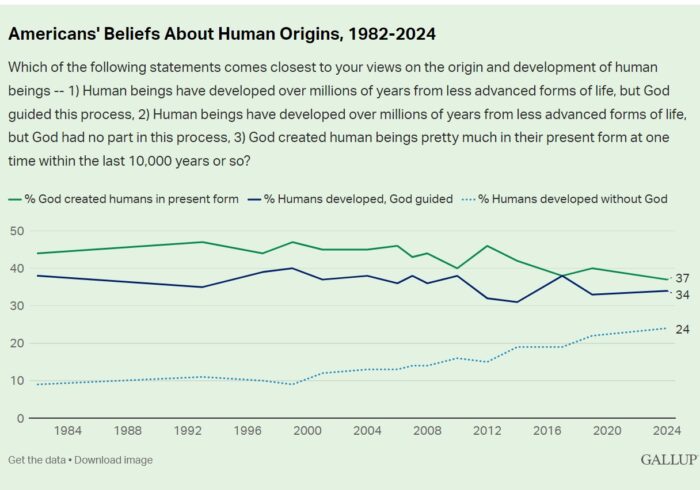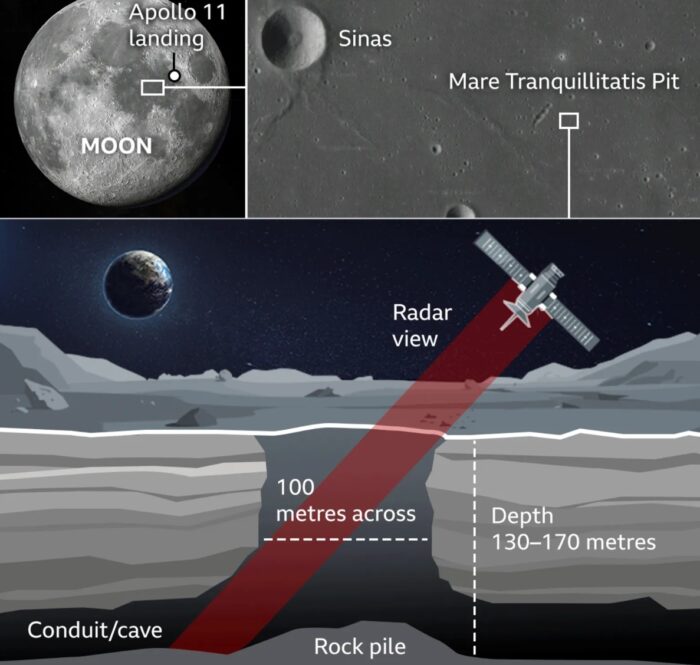Jul 25 2024
Latest Gallup Creationism Poll
 Surveys are always tricky because how you ask a question can have a dramatic impact on how people answer. But it is useful to ask the exact same question over a long period of time, because that can indicate how public attitudes are changing. This is one of the benefits of Gallup, which was founded in 1935 and is dedicated to high quality and representative polls. They have been asking the following question since 1982:
Surveys are always tricky because how you ask a question can have a dramatic impact on how people answer. But it is useful to ask the exact same question over a long period of time, because that can indicate how public attitudes are changing. This is one of the benefits of Gallup, which was founded in 1935 and is dedicated to high quality and representative polls. They have been asking the following question since 1982:
“Which of the following statements comes closest to your views on the origin and development of human beings — 1) Human beings have developed over millions of years from less advanced forms of life, but God guided this process, 2) Human beings have developed over millions of years from less advanced forms of life, but God had no part in this process, 3) God created human beings pretty much in their present form at one time within the last 10,000 years or so?”
It’s an imperfect way to ask these questions – the “less advanced life forms” is not really accurate, and the questions all assume or imply the existence of God. But by asking “which one comes closest” it does capture the essence of this issue. Option 3 is basically young-Earth creationism, option 2 is pure scientific evolution, and option 1 is everything else. From my view as a skeptic and science communicator, the results of this survey are dismal but also encouraging. At the start of the survey in 1982 the numbers were stark: 1 – 38%, 2 – 9%, and 3 – 44% (the rest undecided). Therefore 82% of Americans endorsed some form of creationism, and only 9% were willing to say that life resulted from evolution acting all by itself.
The most recent poll from this perspective is encouraging: 1 – 34%, 2 – 24%, and 3 – 37%. There is still a plurality endorsing young-Earth creationism, but those endorsing scientific evolution is up to 24%. These numbers also track with surveys on religion in the US. The young-Earth creationism figure is about the same as the number of Americans who identify as some kind of evangelical (something between 30 and 39%). Admittedly, this number can be squirrely depending on how you define “evangelical” and ask the question, but broadly defined, the numbers track. The scientific evolution numbers also track with those who answer on surveys that they are religiously unaffiliated, also now in the 20’s.

 Often times the answer to a binary question is “yes”. Is artificial intelligence (AI) a powerful and quickly advancing tool or is it overhyped? Yes. Are opiates useful medicines or dangerous drugs? Yes. Is Elon Musk a technological visionary or an eccentric opportunist? This is because the world is usually more complex and nuanced than our false dichotomy or false choice simplistic thinking. People and things can contain disparate and seemingly contradictory traits – they can be two things at the same time.
Often times the answer to a binary question is “yes”. Is artificial intelligence (AI) a powerful and quickly advancing tool or is it overhyped? Yes. Are opiates useful medicines or dangerous drugs? Yes. Is Elon Musk a technological visionary or an eccentric opportunist? This is because the world is usually more complex and nuanced than our false dichotomy or false choice simplistic thinking. People and things can contain disparate and seemingly contradictory traits – they can be two things at the same time. This kind of abuse of deepfake endorsements was entirely predictable, so it’s not surprising that
This kind of abuse of deepfake endorsements was entirely predictable, so it’s not surprising that  Astronomers have discovered multiple “pits” on the surface of the moon – these look superficially like craters, but on closer inspection are actually vertical pits. There has been considerable speculation that these pits might be cave openings. Now,
Astronomers have discovered multiple “pits” on the surface of the moon – these look superficially like craters, but on closer inspection are actually vertical pits. There has been considerable speculation that these pits might be cave openings. Now,  By now most people have heard that on Saturday there was a failed assassination attempt on candidate Trump at a rally. While it has only been a few days,
By now most people have heard that on Saturday there was a failed assassination attempt on candidate Trump at a rally. While it has only been a few days,  What was the greatest invention of human civilization? Arguably it was agriculture, which allowed for civilization itself. Prior to agriculture humans were some combination of hunters, gatherers, scavengers, and fishers. We lived off the land, which was a full-time job. Many communities had to be nomadic, to follow prey and follow the seasons. There were some permanently occupied sites, if they were in proximity to an adequate food source. Food was the ultimate limiting factor on human populations and ingenuity.
What was the greatest invention of human civilization? Arguably it was agriculture, which allowed for civilization itself. Prior to agriculture humans were some combination of hunters, gatherers, scavengers, and fishers. We lived off the land, which was a full-time job. Many communities had to be nomadic, to follow prey and follow the seasons. There were some permanently occupied sites, if they were in proximity to an adequate food source. Food was the ultimate limiting factor on human populations and ingenuity. In an optimally rational person, what should govern their perception of risk? Of course, people are generally not “optimally rational”. It’s therefore an interesting thought experiment – what would be optimal, and how does that differ from how people actually assess risk? Risk is partly a matter of probability, and therefore largely comes down to simple math – what percentage of people who engage in X suffer negative consequence Y? To accurately assess risk, you therefore need information. But that is not how people generally operate.
In an optimally rational person, what should govern their perception of risk? Of course, people are generally not “optimally rational”. It’s therefore an interesting thought experiment – what would be optimal, and how does that differ from how people actually assess risk? Risk is partly a matter of probability, and therefore largely comes down to simple math – what percentage of people who engage in X suffer negative consequence Y? To accurately assess risk, you therefore need information. But that is not how people generally operate. How’s that for a provocative title? But it is technically accurate. The title of
How’s that for a provocative title? But it is technically accurate. The title of  Paranormal phenomena tend to wax and wane in the public interest. Typically a generation will become fascinated with a topic, but eventually the novelty will wear thin and interest will fade. But the flame will be kept alive by the hardcore believers. Wait long enough, and interest will come around again. We are seeing this today with UFOs (Unidentified Flying Objects, now technically terms UAPs or Unidentified Anomalous Phenomena).
Paranormal phenomena tend to wax and wane in the public interest. Typically a generation will become fascinated with a topic, but eventually the novelty will wear thin and interest will fade. But the flame will be kept alive by the hardcore believers. Wait long enough, and interest will come around again. We are seeing this today with UFOs (Unidentified Flying Objects, now technically terms UAPs or Unidentified Anomalous Phenomena).




